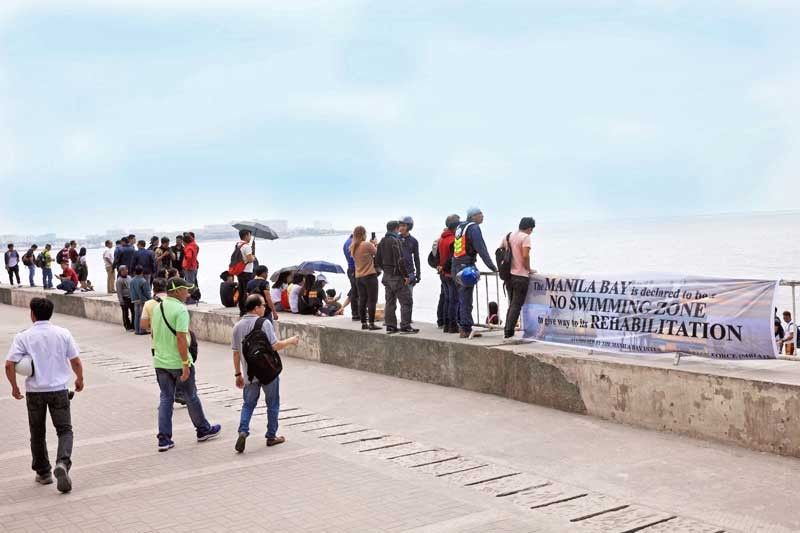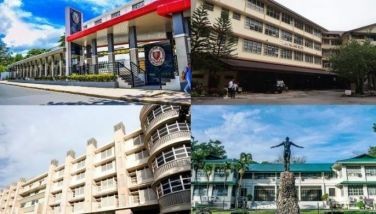No more swimming: Manila Bay to be fenced off

MANILA, Philippines — Environment Secretary Roy Cimatu led yesterday the installation of a fence along the Manila Bay boardwalk on Roxas Boulevard to prevent residents from swimming in the polluted waters during the rehabilitation of the bay.
The government is now strictly implementing the ban on swimming in the bay after a teenage girl almost drowned recently while swimming in the polluted waters.
Cimatu said that Manila Bay remains unsafe for bathing due to high levels of “fecal coliform bacteria” in the water, and the bay remains a “no-swimming zone.”
Fecal coliform level in Manila Bay, prior to the launching of the rehabilitation program, was recorded at 330 mpn per 10 milliliters. The acceptable level is 100 mpn per 100 milliliters.
Cimatu said that high fecal coliform in the bay could cause typhoid fever, hepatitis, gastroenteritis, dysentery and ear infections.
The Department of Environment and Natural Resources said a four-foot fence will be set up along the bay walk from the US embassy to the Manila Yacht Club.
The Department of Public Works and Highways (DPWH) is conducting the desilting of Manila Bay waters to remove the 40- to 50-year-old silt and garbage at the bottom of the bay.
A diversion drainage will be constructed along the seaside through which wastewater of nearby establishments will pass, all the way to the Manila Yacht Club where a water treatment plant will be constructed.
Cimatu said the water treatment facility will ensure that clean water would be dumped to Manila Bay.
Environment Undersecretary Sherwin Rigor said the garbage to be desilted from the bay is about one to three meters in depth and has been there for more than 40 years.
Rigor said the first thing they have to do is identify the submerged materials and see what is the best strategy for the cleanup.
The DPWH would deploy heavy equipment for the desilting of garbage and construction of the diversion drainage canal within a month.
DPWH Bureau of Equipment director Toribio Noel Ilao said his office will start deploying heavy equipment in Manila Bay for silt removal operations starting this month.
Ilao said their recent survey of a 1.5-kilometer stretch of Manila Bay revealed that it is heavily silted due to the accumulation of solid waste over the years.
Cimatu said the desilting and construction of the canal would continue until Manila Bay is fully rehabilitated and back to its old form.
The Manila Bay Rehabilitation Task Force composed of the DENR, DPWH, National Historical Commission and other attached agencies intends to achieve a sustainable Manila Bay rehabilitation program.
“My mission is to rehabilitate Manila Bay, like what we did in Boracay. We will implement the comprehensive plan for the rehabilitation of Manila Bay,” Cimatu said.
Cimatu said people will be allowed to come and see the sunset and sunrise in Manila Bay, but they cannot swim in the bay.
“We could realize the total rehabilitation of Manila within three to seven years and we do not know what will happen beyond that. But I am very optimistic that the succeeding administration would continue the good programs that we will leave involving Manila Bay,” Cimatu said.
P42-billion budget
President Duterte has allocated P42 billion for the rehabilitation of Manila Bay over three years and at least three government agancies would be working together to carry out the mission dubbed the “Battle for Manila Bay.”
Cimatu said that around P6 billion or roughly 14 percent of the budget will be used for cleanup activities, including information and educational campaign on the importance of keeping Manila Bay clean.
He said the remaining P36 billion will be spent for relocation and provision of support systems like access to jobs and livelihoods and construction of town centers with recreational areas, markets, church, schools and hospitals. – With Louise Maureen Simeon, Elizabeth Marcelo, Mayen Jaymalin
Related video:
- Latest
- Trending






























